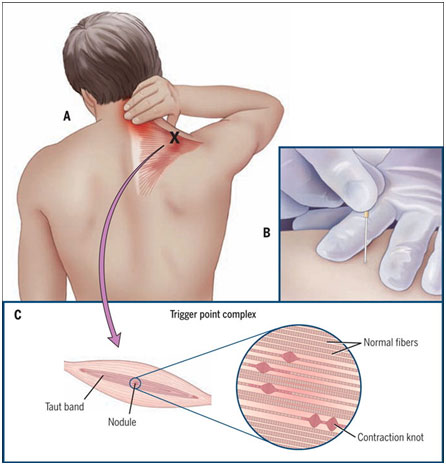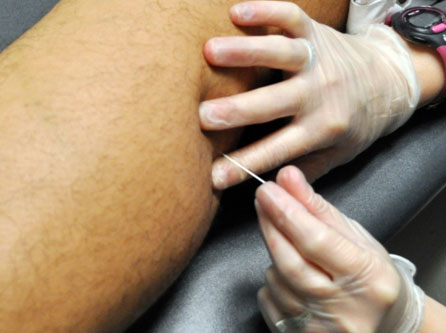Dry Needling Pin Point Relief of Muscle Pain
What is Dry Needling and How Can it Help You?
The trigger point is a direct and palpable source of pain, often containing multiple contracted knots in the muscle that may feel like tight bands. These “muscle knots” can cause pain, limit motion and affect performance. If left untreated, they can worsen over time. Trigger point dry needling is a treatment used by physical therapists to eliminate these trigger points. It involves inserting a sterile thin filament/acupuncture needle into the tight or sore muscle. It is called “dry needling” because, unlike a steroid injection, no substance is put into the body. When the needle penetrates the knots in a muscle, it elicits a twitch response, indicating a release or deactivation of the painful trigger point. At the cellular level, the muscle’s physiology changes to better absorb calcium, improve circulation, encourage tissue remodeling and promote healing. This process can be compared to re-booting the hard drive on a computer.
Dry Needling, Combined With Other Physical Therapy Treatments, Can Help the Following Conditions:
- Acute and chronic tendonitis/tendinosis
- Athletic overuse injuries
- Baseball throwing related tightness/discomfort
- Carpal tunnel syndrome
- Chronic pain conditions
- Ehlers Danlos Syndrome
- Frozen shoulder
- Fibromyalgia
- Groin and hamstring strains
- Headaches and whiplash
- Hip pain and knee pain
- IT band syndrome
- Muscle spasms
- Neck and lower back pain
- Post-traumatic injuries, motor vehicle accidents, and work related injuries
- Repetitive strain injuries
- Sciatic pain
- Shoulder pain
- Tennis/golfer’s elbow
- TMJ
- Many other musculoskeletal conditions
How Long Does it Take for Dry Needling to Work?
In many cases, improved mobility is immediate and decreased pain is felt within 24 hours. Typically, it may take a few treatment sessions (once a week for 2-3 weeks) for a lasting positive effect.
What are the Advantages of Dry Needling?
- Access – The advantage over other techniques is that we can treat parts of the muscle and deeper layers of muscles which our hands and fingers cannot reach, and it works faster than massage at relaxing the muscles.
- No Drugs – There are no drugs used in dry needling, so we can treat many trigger points during each treatment.
- Immediate Relief – Deactivation of the trigger points can bring immediate relief of symptoms, and then we can immediately stretch and train the muscles to work in their new pain free range of motion. Thus, results are achieved with dry needling which cannot be obtained with any other treatment.
This Sounds Like Acupuncture
Both services do use the same needles, but that’s where the comparisons end. Our basic understanding of acupuncture is that it is more of an Eastern medicine practice in origin emphasizing energy or flow in relation to the body’s meridians. Conversely, dry needling is more of a Western medicine practice where we target specific problem areas within the muscles themselves.
Does Dry Needling Hurt?
We use very thin filament needles. The initial feeling of the needle entering through the skin is very minimal; much less than a vaccination or having blood drawn. Once the needle reaches the muscle, the twitch sensation feels more like a deep cramp and doesn’t last long (15-30 seconds). Muscle soreness after a treatment session, may last 12-24 hours, commonly called being “needle sore” but the long-term results are worth it!
Will Dry Needling Help Me?
Individuals who see good results with massage, but are disappointed when the discomfort returns, will find dry needling a better way to get longer-lasting and deeper relief. Dry Needling allows us to treat almost any muscle in the body, and treat the muscle at depths impossible with other types of bodywork. Many trigger points are just too deep in the tissue for massage, even deep tissue work, to treat effectively. Dry needling is a great way to get more out of your physical therapy by allowing us to eliminate the deep knots and restrictions that have, up until now, been unreachable.
How Many Needles Will I Need?
We like to start slowly during the first session to give you a feel for the technique. The first session will focus on a few muscles that are key to your problems. These key areas can give you excellent relief with less soreness. Subsequent treatments will target more specific areas to fine-tune the effect. Sessions are usually spaced 5-7 days apart and you should expect to feel a marked difference after only 2 or 3 sessions.
How Will I Feel After Dry Needling?
You will know positive change has occurred right after the session, as you should have decreased pain and increased mobility and because you will be sore in the way that you would feel after a heavy work out. The muscle will feel fatigued, and the soreness can last from a few hours to 1 or 2 days, but should not interfere with your everyday activities. We encourage you to be active during this time to keep the soreness to a minimum. You can continue your normal activities and gym routine. After a day or so, you’ll experience a new and lasting feeling of less pain and tightness. The injury and pain you thought was there to stay will actually start to diminish. If you’ve been having long standing, chronic muscle pain we’d welcome the opportunity to explain this treatment option in more detail and answer any questions you may have.



